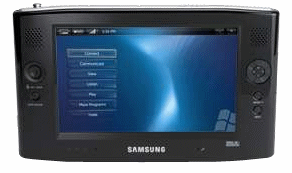Microsoft today announced the final piece in its “Origami” marketing
puzzle.
After creating online buzz and curiosity, the software giant
unveiled its Ultra Mobile Personal Computer (UMPC) platform as the first
step in its goal of making Windows computers as ubiquitous as mobile phones.
Priced between $599 and $999 and weighing fewer than two pounds, the
devices sport a seven-inch touch screen, two-and-a-half-hour battery life and
30GB or 60GB hard disks.
Developed by Microsoft and Intel, the devices are expected to reach
store shelves by the second half of 2006, according to Microsoft.
Samsung is expected to ship the first devices in April under the Q1
Ultra Mobile PC brand.
 |
Samsung’s offering. Source: Microsoft |
While initially UMPC devices will use Windows XP Tablet PC Edition
2005, Microsoft said later computers will run Windows Vista, Redmond’s
new operating system. The devices will use Intel Celeron M, Pentium M or
VIA processors.
Microsoft Touch Pack for Windows XP powers the touch-screen user
interface. Applications are categorized and launched via large buttons
and icons. A touch-screen Microsoft Soduku game is also included.
Features aside, analysts are paying more attention to the hype that Microsoft’s marketing campaign has generated for gear that it hasn’t always been lucky with.
“This road has got a lot of corpses on it,” Leslie Fiering, a Gartner
analyst, told internetnews.com. Microsoft doesn’t have a good record with new mobile platforms, she added, noting Spot watches and tablet PCs.
Although the concept of carrying your pictures, music, data and
applications in a small mobile package -– what Fiering calls “My
Stuff Anywhere” -– is sound, there
will be a backlash from consumers unless the hardware is more robust, the analyst believed.
While the concept is sound, the Gartner researcher believes success
centers on balancing hype against expectations. Those expectations have
been increased beyond what Microsoft intended, said Joe Wilcox, a
JupiterResearch analyst. (JupiterResearch and internetnews.com are owned by Jupitermedia.)
Wilcox said he sees a resurgence of Microsoft’s product promotion
techniques. While the software maker used Internet newsgroups to build
expectations for Windows 95, today’s audience is made of bloggers more familiar
with online viral marketing.
Bloggers first discovered a Flash promo created by Digital Kitchen, then Microsoft unveiled its own Web site, teasing
consumers with a lack of details. Bloggers quickly shared the
discoveries and commented widely upon the possible implications.
“Microsoft orchestrated a leakage campaign that was quite extensive,”
Roger Kay, principal of research firm Endpoint Technologies, told
internetnews.com. The software firm leaked bloggers some details,
while holding back other information.
The publicity tactic stretched to
limiting the number of equipment makers, said Kay, who were briefed about
Origami under an NDA.
Microsoft’s publicity surrounding Origami was much more Apple-like,
according to the analyst.
Tech companies are turning to viral advertising and enlisting the
help (sometimes unwittingly) of bloggers, according to Fiering.
Companies are changing tactics to reach young people who aren’t swayed
by traditional advertising methods.
Will we see more Origami-like ad campaigns? Sure, said Wilcox.
“Hype is good. But if you hype, you have to deliver.”


